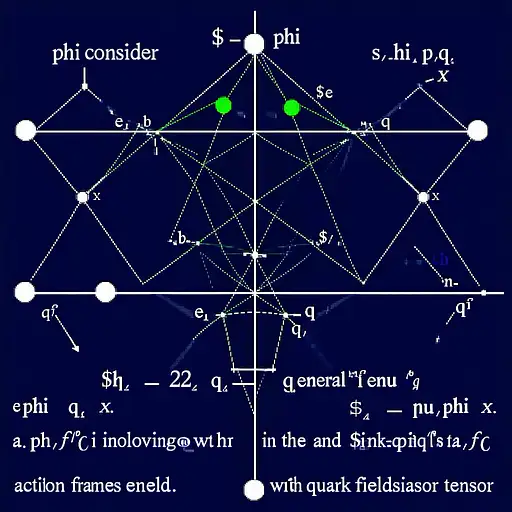
9 hours ago
We consider the action $S_{\phi q}$ involving only $\phi_{\mu\nu}$ and quark fields $q(x)$ in general frames with Poincar\'e metric tensor $P_{\mu\nu}$: \be S_{\phi q} = \int (L_{\phi q} + L_{gf})d^4 x, \ee %%%%%%%%15%%%%22%%%%%24%%%22%%%19 \be L_{gf}=\frac{1}{2g^2}\e_{\a\b}\left[\p_\mu J^{\mu\a} - \frac{1}{2}\e^{\a\ld}\p_{\ld} J^\mu_\mu\right] \left[\p_\nu J^{\nu\b} - \frac{1}{2}\e^{\b\ld}\p_{\ld} J^\nu_\nu\right], \ee %%%%16%%%%%%%23%%%%%25%%%23%%%%20 where $L_{\phi q}$ is given in (7) with the $T(4)$ gauge curvature $C_{\mu\nu\a}$ given by (5). We have included a gauge-fixing term $L_{gf}$ specified by (20) involving ordinary partial derivative to break the $T(4)$ gauge symmetry so that the solution of gauge field equation is well-defined. The reason for including $L_{gf}$ is that field equations with gauge symmetry are known to be not well defined in general and that it is a nuisance to find explicit solutions of such field equations without having a gauge-fixing term. The quark fields play the source for producing a gravitational potential field $\phi_{\mu\nu}$. The $T(4)$ gravitational field equation for symmetric tensor field, $\phi_{\mu\nu}=\phi_{\nu\mu}$ can be derived from (19), \be H^{\mu\nu} + A^{\mu\nu}= \frac{g^2}{2} Sym \ \left[ \overline{q} i\G^\mu D^\nu q - i(D^\nu \overline{q}) \G^\mu q \right]\equiv g^2 T^{\mu\nu} , \ee %%%%%26%%%17%%%%%%%%%24%%%%%%26%%%24%21 $$ H^{\mu\nu} = Sym \left[D_\ld (J^{\ld}_\rho C^{\rho\mu\nu} - J^\ld_\a C^{\a\b}_{ \ \ \ \b}P^{\mu\nu} + C^{\mu\b}_{ \ \ \ \b} J^{\nu\ld}) \right. $$ %%%%%%%%%%%%%%%%%%%%%%%%20%%% \be \left. - C^{\mu\a\b}D^\nu J_{\a\b} + C^{\mu\b}_{ \ \ \ \b} D^\nu J^\a_\a - C^{\ld \b}_{ \ \ \ \b}D^\nu J^\mu _\ld\right], \ee %%%%%%%27 %%%%%%%%%%18%%%%%%%%%25%%%27%%%%25%%522 \be A^{\mu\nu} =Sym \left[ \p^\mu \left(\p^\ld J_\ld{^\nu} - \frac{1}{2} \p^\nu J \right) - \frac{\e^{\mu\nu}}{2} \left(\p^\a \p^\ld J_{\ld\a} - \frac{1}{2} \p^\a \p_\a J \right)\right], \ee %%%19%%%%%%%%%%26%%%%%%%%28%%%%%26%%%523 where $D_{\mu}q=\p_{\mu}q$ and $J= J^\ld_\ld$. The symbol `Sym' in Eqs. (21)-(23) denotes that $\mu$ and $\nu$ should be made symmetric.





